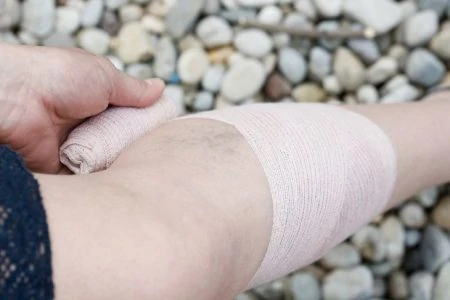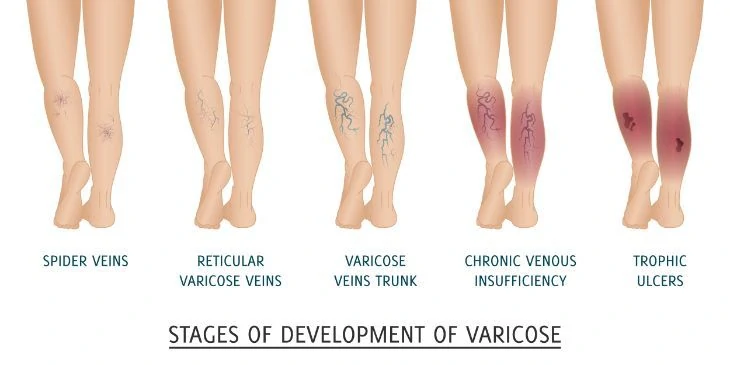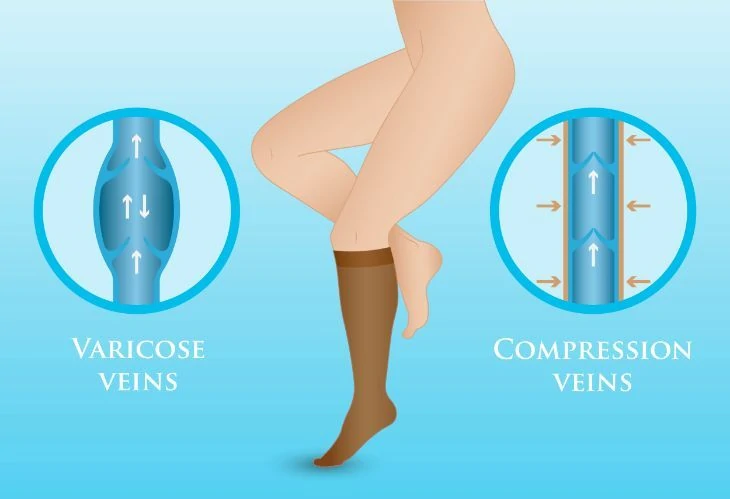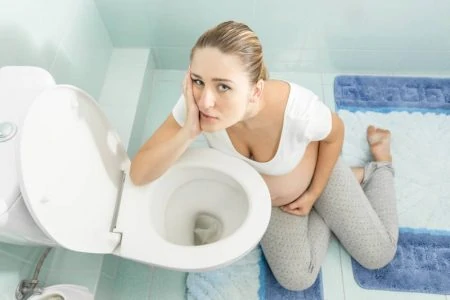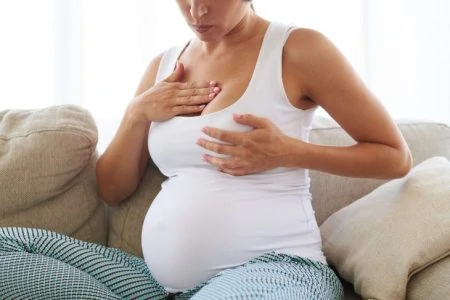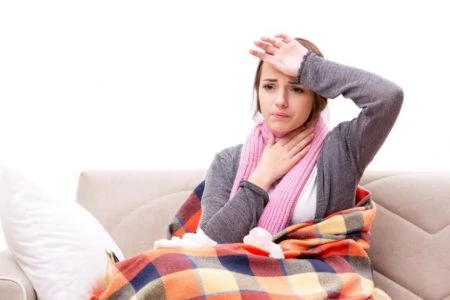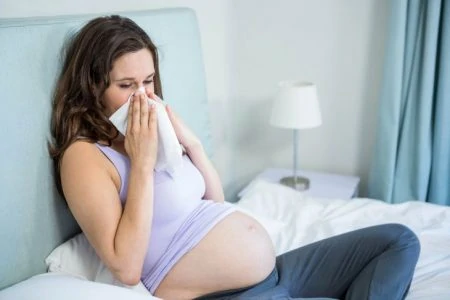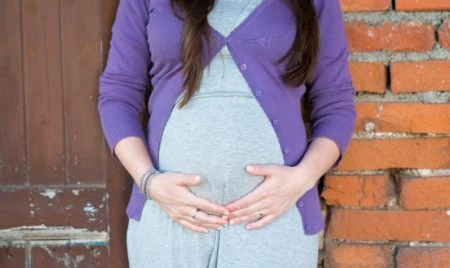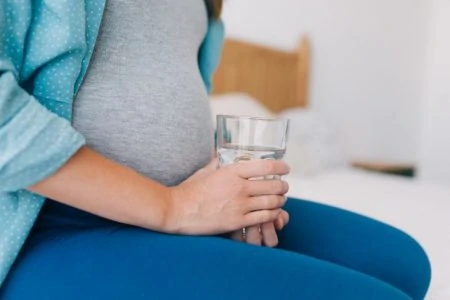Are you starting to see unsightly varicose veins now that you’re pregnant?
Pregnancy has a lot of unwanted side effects, and varicose veins are, unfortunately, one of them. It doesn’t seem fair that most of the things that happen during pregnancy make women feel unattractive, especially when they may already be struggling with all the changes going on in their bodies.
In this article, we’ll share all we’ve learned about varicose veins, including what causes them, what you can do about them, and how soon you can expect them to go away.
Key Takeaways
- Varicose veins are enlarged, swollen veins that can appear during pregnancy due to increased blood volume and hormonal changes.
- Common symptoms include swelling, itching, tired legs, and changes in skin color around the veins.
- Varicose veins usually aren’t dangerous, but in some cases, they can indicate a more serious condition like deep vein thrombosis.
- To minimize varicose veins during pregnancy, exercise, use compression stockings, elevate legs, manage constipation, and maintain a healthy weight.
What Are Varicose Veins?
It’s easy to spot veins on practically everyone if you look hard enough. They are usually a faint, slightly bluish or red color just under the skin.
And then there are varicose veins.
There is nothing slight about these bad boys, and you don’t have to search hard to find them either. They are veins that have become enlarged and filled to the brim with blood.
Varicose veins look swollen, big, raised from the rest of your skin, and they are often blue, purple, or red. The reason they can have a blue color is that the blood stuck in the veins is deoxygenated. Without being recirculated back to the heart and pumped to the lungs, it doesn’t receive oxygen.
Varicose veins can be found in your legs, ankles, and even your genitals. As if that’s not bad enough, varicose veins can also be painful.
Did you know that hemorrhoids are a form of varicose veins in the anus or rectum, often a result of constipation? Those can be the most painful of all.
Editor's Note:
Dr. Njoud Jweihan, MDHow Are Varicose Veins Diagnosed?
This isn’t a difficult condition to diagnose. You won’t have to undergo any blood tests or other special tests. It’s pretty straightforward.
Your doctor will perform a physical examination to look at your veins and ask you some questions about your medical history, including any prior leg or vein problems you might have had. Your doctor might ask you questions about whether you stand for long periods of time, if you’ve gained any weight recently, or if you have a family history of varicose veins. But the appearance is what will really make up your doctor’s mind.
From there, the doctor might ask you about any symptoms you’ve had with your varicose veins, such as pain, swelling, achiness, and heaviness around the veins. The doctor should also go over anything you can do to make your veins feel better.
If any complications are suspected in deeper veins, you might need additional testing, such as an ultrasound, to check your blood flow and learn if there are any blood clots.
It is important to note that, for some people, varicose veins do not cause any pain and can be only a cosmetic concern.
What Causes Varicose Veins?
You can blame varicose veins on weak valves in your body. Your veins’ one-way valves should keep pushing blood up to your heart.
But sometimes, those valves become less efficient and don’t push all the blood up. It can pool in your veins just below the surface of your skin. As the pressure grows, the veins become more prominent.
Why do some women get varicose veins while others don’t?
There are many reasons.
- Age: You tend to get more varicose veins the older you get. Varicose veins affect 50 percent of people who are 50 and older.
- Gender: Women are more likely to get varicose veins than men, especially while pregnant, going through menopause, taking birth control pills, and during pre-menstruation. This is due to alternating hormones that relax the vein’s walls.
- Heredity: Some women seem to win the genetic lottery, not suffering from stretch marks, cellulite, or varicose veins during or after pregnancy. Other women get all three. There’s not much you can do to fight genetics.
- Pregnancy: Pregnancy creates more pressure on your leg veins because of increased blood volume. Hormonal changes can also be responsible for weakening the vein’s elastic wall.
- Extra pounds: Being overweight can up your chances of having varicose veins, whether you’re pregnant or not.
- Being on your feet too much: Having jobs or hobbies where you stand for a long time can cause varicose veins.
The Symptoms of Varicose Veins
You’ll usually be able to feel varicose veins as well as see them. Most people will notice other symptoms, which can range in severity, and some people might not even feel pain. Some are mildly annoying, while others can be more problematic.
These are some of the common symptoms (1):
- Swelling of ankles and feet.
- Itchy skin over the top of the vein.
- Tired feeling legs.
- Burning in your legs.
- Swelling in legs — not just ankles — and feet.
- Calf pain.
- Changes in skin color.
- Scaling or inflammation of your skin.
- Sores or easy bleeding.
- Ulcers forming around the veins.
Are They Dangerous?
But even though they can look awful at times, they usually don’t pose a big problem. They may feel bad, but your health and your baby’s health will still be fine.
But occasionally, it can point to a larger problem requiring treatment. Sometimes varicose veins can signify you have a more serious blockage known as deep vein thrombosis.
As the name indicates, these veins are located deeper in your body, so they aren’t as obvious and as easy to spot as varicose veins are.
Why It’s Serious
Many cases of deep vein thrombosis are caused by too much sitting or from an injury. Having severe varicose veins can increase the chance of developing a deep vein blood clot.
Another potential complication of varicose veins is how much they can bleed.
With varicose veins, if you were to cut your leg and nick the vein, it could result in a bloody mess. While any vein will bleed when nicked, varicose veins are full of pressure, so they could bleed more than a regular vein would.
If you find yourself with a cut that goes into the vein while you’re pregnant, you should elevate the injury and use very firm pressure on the wound until the bleeding from the vein stops. Contact your doctor or consider going to the hospital if the bleeding does not stop since this can lead to unconsciousness and more dangerous consequences.
Will They Go Away After I Give Birth?
For pregnant women, that’s the $64,000 question. None of us want to see these unattractive, bulgy veins stay with us after childbirth.
So what happens? Do they go away? Unfortunately, there’s no clear-cut answer, so we’ll have to go with maybe.
The veins do subside or improve for some women, but it doesn’t happen overnight. You may not see improvement for three months and sometimes even longer. They didn’t happen overnight, and they won’t go away that quickly either.
Some women won’t see as much shrinkage of their varicose veins, particularly if they:
- Had them before they become pregnant.
- Have other relatives who have varicose veins.
- Have had more than one pregnancy.
- Are overweight.
- Tend to stay on their feet for a long time every day.
These women will have a harder time getting rid of their varicose veins without intervention. And if it were merely a cosmetic problem, some women might not mind as much. But because they can be painful, achy, burning, and itchy, it can be even more troubling.
If you find your varicose veins don’t go away by a year after you’ve delivered your baby, and if they continue to bother you, you may want to consider getting treatment for them.
You have several options, including:
- Ligation and stripping the vein: This involves making small cuts over the veins, tying them off, and removing the veins.
- Stab avulsion, also known as phlebectomy: This is when multiple small incisions are made in the skin so the varicose veins can be taken out (2).
- Lasers: Lasers can be used on the outside of the skin to take care of smaller veins, or they can be used inside the vein to force them to close up.
- Foam or chemical sclerotherapy: This uses foam or a chemical to harmlessly close off the vein by damaging and scarring the inside of it. This method works best if the vein isn’t too large.
- Radiofrequency ablation: Radiofrequency is used to scar the inside of a vein and help close it up. This method works well for big varicose veins.
You don’t need to seek treatment if you don’t find your veins particularly troublesome and you’re not worried about the cosmetic impact on your appearance. When women seek treatment, it’s usually because of one of two reasons — the appearance or the discomfort.
Keep in mind, though, just because you’ve had varicose veins removed, it doesn’t mean new ones can’t pop up. You might find yourself getting more treatments at a later date. It’s OK to do that, but it can get expensive after a while.
What Can I Do To Make Them Less Prominent?
There are a few things you can do at home to help control your veins. While the following measures won’t make varicose veins go away entirely, they may help them become less noticeable
1. Get Your Exercise
Some women complain that exercise makes their varicose veins feel worse, but it can actually help. It can ease some of the pressure off the veins by improving circulation.
And since one of the risk factors for varicose veins is excessive sitting and being overweight, exercise during pregnancy is a good idea.
You should get a good mix of exercise. Walking is an excellent option if you have varicose veins. Other exercises can include lunges, leg lifts, and bicycling.
While you can still run, you need to be aware that it could make your vein swelling even worse. So you might want to proceed with caution, and keep your runs brief until you see if running aggravates your condition.
One thing you’ll want to be cautious of is weight lifting. You don’t want to cause further pressure in your veins, and you don’t want to strain your body and possibly worsen your situation.
2. Use Compression Stockings
Compression stockings can squeeze your leg enough that it helps give pressure where it’s needed to take some of the strain off those veins.
You should ask your health care provider if compression stockings will be a good option for you. And you should make sure the compression stockings aren’t overly tight. You want them to be snug without cutting off your circulation in other places.
That’s especially true if your compression stockings cover your belly as well. Having tight things on your belly isn’t ideal during pregnancy, and you might find it annoying anyway.
As a bonus, they can help with that achy, tired leg sensation and can help you avoid other problems such as deep vein thrombosis and feeling lightheaded when you stand up (3).
3. Elevate Your Legs
Whenever you get a chance, you should prop up your legs when you’re pregnant. It will help you reduce the swelling in your ankles and calves that can make your lower legs look like tree trunks, and it can also help you fight varicose veins.
But to get the maximum benefit, you need to keep your legs higher than your heart.
4. Get a Handle on Constipation
Constipation isn’t fun, and the extra iron you’ve been taking in your prenatal vitamin can bind you up in record time. To help fight that feeling, eat plenty of fiber, drink a lot of water, and if you’re still having trouble, you might want to check with your doctor about taking a stool softener. This can help cut the straining and grunting down to a minimum to prevent hemorrhoids from forming.
5. Watch That Weight
If you’ve spent a lifetime watching your weight, pregnancy can feel like you’ve just been given permission to make every day an all-you-can-eat buffet. But that’s the wrong approach. You only need about 300 extra calories per day during your pregnancy.
If you gain a lot of weight rapidly during pregnancy, you open yourself up to many problems, including a higher risk of varicose veins.
Other Types of Vein Issues During Pregnancy
Varicose veins aren’t the only vein problems you’ll struggle with during pregnancy. Two other types may prove to be problematic.
1. Hemorrhoids
Hemorrhoids are swollen veins found in the anus and rectum areas (4). The likeliest time for women to develop them is during pregnancy due to some major constipation issues.
But you shouldn’t blame all your bad luck on your pregnancy.
Even without pregnancy, you might end up with hemorrhoids because the risk goes up as you age. And other things like obesity, not eating enough fiber, or sitting too much can cause them.
If you find you have hemorrhoids either during pregnancy or after, here are some steps you can take to help with the symptoms, which can include pain, itching, and swelling.
- Creams and ointments: You can get creams with hydrocortisone as the active ingredient and pads with witch hazel or other numbing ingredients.
- Sitz bath with warm water: A sitz bath is a shallow water bath that only covers the butt and hips. The warm water can be soothing when you’re experiencing hemorrhoid symptoms.
- Moist towelettes: These can be used in place of dry toilet paper, which may irritate your hemorrhoids.
- Medication: Painkillers like Tylenol, Advil, or aspirin can help you with the pain of hemorrhoids. But if you’re still pregnant, the only suitable painkiller to take out of these options is Tylenol (5).
- Ice packs: Ice can help take the sting out of many ailments, plus it can calm any swelling.
- Witch hazel: This is the ingredient in TUCKS pads. If you place one over your hemorrhoids, it will act like an astringent to ease swelling and inflammation.
- Cotton Underwear: Wearing loose-fitting cotton underwear to reduce extra sweat around the area.
If you find your hemorrhoids are still a problem months after pregnancy, you can talk to your doctor about your options. What your doctor suggests to remedy the hemorrhoids will depend upon whether they’re internal or external hemorrhoids.
You might be a candidate for surgery or non-surgical methods like rubber band ligation, where the blood supply to the hemorrhoids is cut off.
If you’re still in the early phases of pregnancy and haven’t been cursed with hemorrhoids, you still have time to prevent them from possibly happening.
Here is what you can do:
- Avoid constipation at all costs: Constipation is one of the triggers for hemorrhoids. The more you strain, the more pressure builds up in those veins below.
- Don’t wait, defecate: Poop when you need to — don’t try to hold it in. We’re not handing out any medals for holding it in. If you don’t go when the urge strikes, your stool can get drier, which will make it harder to get out.
- Munch on some fiber: Fiber gets things moving along in your system. So nosh on fruits, veggies, and whole grains. It will stop you from straining when the time comes to go to the bathroom.
- Drink those fluids: Avoid dehydration — make sure you’re getting enough to drink. That’s especially important when you’re pregnant, as you need more fluids anyway.
- Keep moving: If sitting causes hemorrhoids, then exercise will be a good prevention method. It will encourage more regular movements, keep you at a healthier weight, and cut back on the pressure on the veins in your anus and rectum.
2. Spider Veins
Spider veins are different than varicose veins. They’re like a smaller, less ugly version of them.
Don’t get me wrong — spider veins are no picnic either. They can make you feel bad about baring your legs during the summer months, but they aren’t as noticeable as varicose veins are.
Spider veins can show up on the legs, face, and other areas. They are small and usually are bluish or red. They’re called spider veins because of the spider-web-like appearance they can take on.
They happen during pregnancy because your body contains more blood to support growing a whole other life. That extra blood means more pressure on your blood vessels (6). That increase can cause even your tiny veins to swell up. In addition, a hormone directly related to spider veins is estrogen — one of the common hormones of pregnancy.
Spider veins usually aren’t permanent; they generally go away in three or four months.
There are a few things you can do to keep spider veins to a minimum during pregnancy.
- Eat your fiber: Constipation can even cause smaller veins to show up, so that’s why getting enough fiber is important.
- Exercise: Keep those legs moving to work on your circulation.
- Don’t gain weight too quickly: By gaining weight gradually, you can avoid any sudden gains that might cause spider veins to flare.
- Get enough vitamin C: Vitamin C can help you repair veins or keep them healthy in the first place.
- Don’t cross your legs: You might want to forget about being a lady if it means you’ll get spider veins. Uncross your legs, ladies, and prop them up while you’re sitting down.
- Wear support stockings: You’ll want the leg portion of the stockings to have a little compression, but stay away from anything too tight, especially in the waist and groin.
Keep in mind, if you do get spider veins and they bother you appearance-wise, you can use concealer or self-tanning products on them.
FAQs
The Bottom Line
While it’s not foolproof, there are many things you can do to prevent varicose veins, hemorrhoids, and spider veins during pregnancy. These are things you should do anyway, like exercise and ensure you’re taking in enough fiber to avoid constipation.
If you spend just a few minutes a day on some basic precautionary measures, you might be one of the lucky moms to get through pregnancy without as many battle scars.
